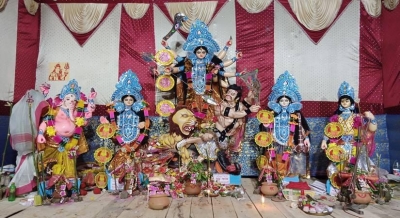Durga Puja, Vijaya Dashami and its significance

New Delhi, Sep 28 : Durga Puja, also known as Durgotsava or Sharodotsava, is an annual Hindu festival celebrated in the Indian subcontinent that honours and reveres the Hindu goddess Durga and commemorates Durga’s victory over Mahishasur.
The first day of Durga Puja is Mahalaya, which marks the arrival of the goddess. On the sixth day, Sasthi, celebrations and worship begin. The goddess is worshipped in her various forms as Durga, Lakshmi, and Saraswati over the next three days.
The celebrations conclude with Vijaya Dashami (Tenth Day of Victory), when sacred images are carried in massive processions to local rivers and immersed amid loud chants and drumbeats “dhaak.” This custom represents the deity’s return to her home and husband, Shiva, in the Himalayas. At various pandals, idols of the goddess riding a lion and attacking the demon king Mahishasura can be found. This year the celebration begins from October 1 and lasts till October 5.
The significance of Durga Puja should be understood in order to enhance the beauty of the celebrations and to comprehend the devotion to Goddess Durga.
According to Hindu mythology, Lord Brahma granted the demon Mahishasura the boon of invincibility, which meant that no man or god could kill him. After receiving the blessing, Mahishasura attacked the gods and chased them out of heaven. To defeat the demon king, all the gods gathered to worship Adi Shakti. Maa Durga was created by the divine light that emanated from all the gods during the puja.
Maa Durga’s battle with Mahishasura lasted ten days. On the tenth day, Goddess Durga slew the demon king, and thus the day is celebrated as Vijaya Dashami, symbolising the triumph of good over evil.
On the last day, devotees immerse Goddess Durga’s idol in the holy Ganges water. It is referred to as Durga Visarjan. Worshippers march in procession before the immersion, accompanied by drumming, singing, and dancing.






